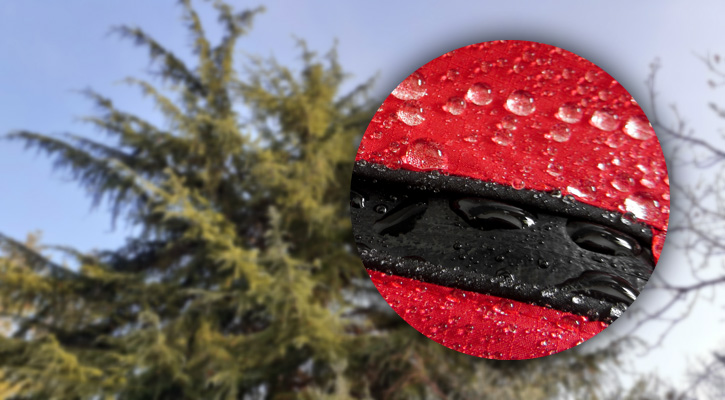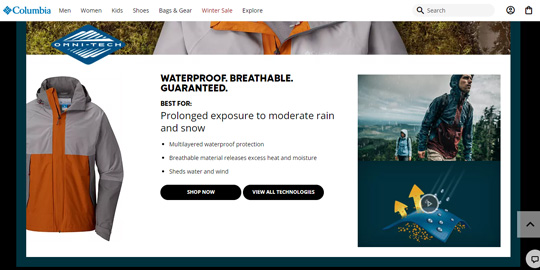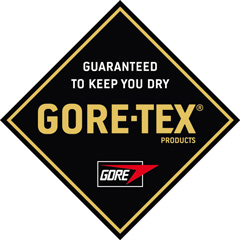
As we explore the world of high-performance fabrics, we face the question: which material offers the best combination of protection from rain and snow, breathability, and price?
In this article, we compare Columbia’s Omni-Tech™ against the industry standard, Gore-Tex®.
Renowned for its waterproof and breathable qualities, Gore-Tex® sets a high bar. However, Omni-Tech™ enters this comparison as a cost-effective alternative.
Join us as we explore these technologies, helping you decide which outdoor gear fabric might be better for you!
Contents:
1. Omni-Tech™
Omni-Tech has been developed by Columbia Sportswear, a popular American brand frequently featured in our selections and comparisons. This technology goes beyond mere waterproofing, boasting stain resistance and breathability.

Omni-Tech: Columbia’s official website
Breathability is a key consideration for waterproof jackets, often overlooked. Skiers, hikers, and runners can attest to the impact of breathability on both comfort and performance. Comprising multiple layers, Omni-Tech features an outer layer treated with Omni-Shield™, providing stain and water repellency.
The water-repelling capability is vital, preventing water accumulation and enhancing protection against rain and snow. The waterproof membrane in the second layer contributes significantly to Omni-Tech’s water resistance. Lastly, the third layer facilitates moisture-wicking through body heat.
Omni-Tech offers a soft, comfortable feel, lacking the stiffness often associated with waterproof fabrics.
The video will be loaded from YouTube.com, a third party. If you play it, you accept their terms of service, and their use of cookies.
2. Gore-Tex®
Decades ago, in the 1960s-70s, Gore-Tex® emerged following the discovery of ePTFE (expanded PolyTetraFluoroEthylene), a highly durable material known for its low water adsorption and countless micropores, roughly 9 billion per square inch.

Gore-Tex® Logo
These micropores enable moisture wicking while effectively blocking external water droplets due to their minuscule size. The outer layer is coated with DWR treatment, enhancing the fabric’s waterproofing by promoting water repellency.
Gore-Tex® can be viewed from three perspectives: as a laminate, bonded between outer textiles and lining, as a membrane, owing to its myriad pores ensuring waterproofing and breathability, and as a versatile technology that can be configured in different performance levels capable of meeting diverse outdoor requirements.
Widely regarded as the pinnacle of waterproof fabrics, Gore-Tex® sets the standard for uncompromising waterproof performance.
Despite the availability of numerous alternatives, Gore-Tex® maintains its position as the premier choice for a comprehensive fabric, offering wind and water resistance, breathability, and exceptional durability.
Learn more: What is Gore-Tex and How Does It Work?
The video will be loaded from YouTube.com, a third party. If you play it, you accept their terms of service, and their use of cookies.
Various Gore-Tex Performance Options
Gore-Tex, recognized for its adaptability, can be customized into various forms to suit various outdoor activities and athletic pursuits. Throughout its history, the company has unveiled numerous iterations of this fabric technology.
Gore-Tex is mainly divided into two primary categories:
- the Original Gore-Tex range, ideal for waterproof apparel and equipment;
- and the Windstopper / Infinium Gore-Tex range, made for non-waterproof clothing and gear suitable for dry, windy conditions.
The Original / Waterproof Gore-Tex range where we’ll be focusing on here, has various options that include:
- Paclite: the most lightweight choice, easily packable, and primarily tailored for casual and everyday use.
- Active: the most breathable option, for intense athletic activities.
- Pro: very durable, ideal for various outdoor activities.
- Shakedry: high water repellency, lightweight and breathable, ideal for rainy sports activities such as cycling.
3. Comparison
Waterproofness
The waterproof rating indicates a fabric’s ability to resist water pressure before leaking occurs. A fabric must have a rating of at least 10,000mm to be deemed waterproof, with higher ratings indicating better performance.
Omni-Tech boasts a 10,000mm water column, meeting the technical waterproof standard, albeit at a moderate level. In contrast, Gore-Tex starts at 28,000mm, positioning it as a highly waterproof fabric capable of withstanding heavy rainfall and snow.
However, the construction of the jacket or other garment using these technologies is crucial, particularly the seams.
Stitched seams should be avoided, as they can compromise the jacket’s waterproofing, regardless of the fabric’s capabilities. So, it’s essential to ensure the jacket features sealed or taped seams for good protection.
Additionally, it’s important to verify whether the jacket is fully seam-sealed or if only critical seams are sealed, as the latter may not provide comprehensive protection from the elements.
Waterproofness:
- Omni-Tech: 10,000mm water column
- Gore-Tex: starts at 28,000mm water column
Breathability
As we previously mentioned, breathability is crucial for a high-performance jacket, particularly for sports and outdoor pursuits.
Technically, breathability refers to a fabric’s capacity to facilitate air circulation and allow moisture vapor to escape, while also aiding in the transfer of moisture from the interior to the exterior, thus preventing overheating and excessive perspiration.
Breathability is quantifiable, with Omni-Tech rated at 10,000 g/m2/24h, while Gore-Tex starts at 15,000 g/m2/24h and can reach up to 25,000 g/m2/24h.
While Omni-Tech offers adequate breathability, it may not be the best choice for those seeking a jacket that can keep pace with rigorous physical activity.
Breathability:
- Omni-Tech: 10,000 g/m2/24h
- Gore-Tex: 15,000 – 25,000 g/m2/24h
Comfort and Durability
The wearing characteristics of these fabrics differ, with Omni-Tech being more pliable and yielding to movement, while Gore-Tex tends to be stiffer. Also, Omni-Tech has a more comfortable feel.
In terms of durability, while Omni-Tech provides reasonable longevity, Gore-Tex is unmatched.
4. Which is Better? Omni-Tech or Gore-Tex?
After considering all aspects, Gore-Tex emerges as the better choice overall between the two, though it’s pricier.
But, your specific needs should also be taken into account.
If you need an affordable jacket for mild weather conditions and outdoor activities with not a lot of movement (lower breathability), Omni-Tech jackets can be a great choice.
On the other hand, if you require a jacket that offers enduring protection against the elements and long-term wear for serious outdoor activities, our recommendation would be to explore the various Gore-Tex technologies.
Read next:
Why is Gore-Tex so Expensive? Is It Worth It?
Powertex vs Gore-Tex: A Comparison
Gore-Tex vs DryVent: Which is Better?
